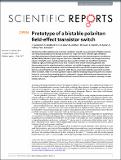Files in this item
Prototype of a bistable polariton field-effect transistor switch
Item metadata
| dc.contributor.author | Suchomel, H. | |
| dc.contributor.author | Brodbeck, S. | |
| dc.contributor.author | Liew, T. C. H. | |
| dc.contributor.author | Amthor, M. | |
| dc.contributor.author | Klass, M. | |
| dc.contributor.author | Klembt, S. | |
| dc.contributor.author | Kamp, M. | |
| dc.contributor.author | Höfling, Sven | |
| dc.contributor.author | Schneider, C. | |
| dc.date.accessioned | 2017-07-11T23:34:26Z | |
| dc.date.available | 2017-07-11T23:34:26Z | |
| dc.date.issued | 2017-07-11 | |
| dc.identifier | 250119233 | |
| dc.identifier | 497f460a-35a8-4213-9b09-3d18c4d8fae3 | |
| dc.identifier | 85023164280 | |
| dc.identifier | 000405172600081 | |
| dc.identifier.citation | Suchomel , H , Brodbeck , S , Liew , T C H , Amthor , M , Klass , M , Klembt , S , Kamp , M , Höfling , S & Schneider , C 2017 , ' Prototype of a bistable polariton field-effect transistor switch ' , Scientific Reports , vol. 7 , 5114 . https://doi.org/10.1038/s41598-017-05277-1 | en |
| dc.identifier.issn | 2045-2322 | |
| dc.identifier.uri | https://hdl.handle.net/10023/11188 | |
| dc.description | This work has been supported by the State of Bavaria. | en |
| dc.description.abstract | Microcavity exciton polaritons are promising candidates to build a new generation of highly nonlinear and integrated optoelectronic devices. Such devices range from novel coherent light emitters to reconfigurable potential landscapes for electrooptical polariton-lattice based quantum simulators as well as building blocks of optical logic architectures. Especially for the latter, the strongly interacting nature of the light-matter hybrid particles has been used to facilitate fast and efficient switching of light by light, something which is very hard to achieve with weakly interacting photons. We demonstrate here that polariton transistor switches can be fully integrated in electro-optical schemes by implementing a one-dimensional polariton channel which is operated by an electrical gate rather than by a control laser beam. The operation of the device, which is the polariton equivalent to a field-effect transistor, relies on combining electro-optical potential landscape engineering with local exciton ionization to control the scattering dynamics underneath the gate. We furthermore demonstrate that our device has a region of negative differential resistance and features a completely new way to create bistable behavior. | |
| dc.format.extent | 2440785 | |
| dc.language.iso | eng | |
| dc.relation.ispartof | Scientific Reports | en |
| dc.subject | QC Physics | en |
| dc.subject | T Technology | en |
| dc.subject | NDAS | en |
| dc.subject.lcc | QC | en |
| dc.subject.lcc | T | en |
| dc.title | Prototype of a bistable polariton field-effect transistor switch | en |
| dc.type | Journal article | en |
| dc.contributor.institution | University of St Andrews. School of Physics and Astronomy | en |
| dc.contributor.institution | University of St Andrews. Condensed Matter Physics | en |
| dc.identifier.doi | https://doi.org/10.1038/s41598-017-05277-1 | |
| dc.description.status | Peer reviewed | en |
| dc.date.embargoedUntil | 2017-07-11 | |
| dc.identifier.url | http://10.1038/s41598-017-05277-1 | en |
This item appears in the following Collection(s)
Items in the St Andrews Research Repository are protected by copyright, with all rights reserved, unless otherwise indicated.

